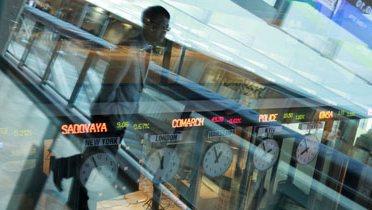The victory of liberal-conservatives in the snap elections on July 7 with 39.6 percent of the votes, sealed the completion of Greece’s transformative journey from radical populism back to a systemic normality. The economic climate has significantly improved—although at odds with the one prevailing in Europe (Figure 1a and 1b)—however, it remains to be seen whether the favorable expectations will endure and translate to a robust economic recovery in the coming months.
Figure 1a.

Figure 1b.
 Source: IFO World Economic Survey, November 2019.
Source: IFO World Economic Survey, November 2019.
Economic optimism
The European Commission’s Economic Sentiment Indicator (ESI)—a composite measure (average of 100)—reached +107 in November. Last month, Standard & Poor’s raised Greece’s sovereign credit rating, from B+ to BB- (one notch) with a positive outlook. Greece also tapped the bond markets in March 2019 by issuing a 10-year Greece Government Bond (GGB)—which raised €1.5 billion with only a 1.5 percent yield. In addition, for the first time, yield-hungry investors lent to Greece last month, in short-term treasury notes, to a negative yield. The tourism sector is rebounding with a 5 percent increase in travelers and 16 percent increase in travel receipts (in September 2019). There is also good news for exports: As of January 1, the European Commission will insert Greece back in the list of “marketable risk” countries for short-term export credit insurance.
In its final budget proposal set last week, the government has set growth for 2020 at 2.8 percent. This is a rather ambitious target given that: (1) GDP for 2019 will drift around 2.0 percent, almost the same rate as 2018, and (2) an uncertain and cloudy international economic environment in which major organizations are projecting a synchronized slowdown (the IMF’s World Economic Outlook expects Greece’s GDP to grow 2.2 percent).
Out of the doldrums but structural problems still there
Despite the economic optimism, the structural problems of the Greek economy are still there, namely bad demographics, very low investment rates, a highly problematic social security system, and continuing brain drain. These are the main reasons that the IMF has lowered long-term growth projections to 0.9 percent in 2023 and onwards. Schools, universities, hospitals, an inefficient justice system, and a sclerotic public administration, all need urgent, serious reforms which will certainly bring serious political costs for the government. For now, nobody knows how much the government is willing to reform, but it is certain that with no action, it will have to face unfortunate economic and financial consequences.
Surely, Greece isn’t out of the woods yet. The IMF expects a deterioration in the country’s future debt path as lower projected sovereign borrowing costs may be more than outweighed by a higher debt-to-GDP ratio. The IMF highlights poor trend prospects on adverse demographics and weak productivity, falling back to 1.4 percent growth in 2022, and 0.9 percent in 2023. It must be emphasized that unfortunate demographic change affects economic growth directly through household savings and labor supply decisions, as well as growth indirectly through the pension system’s funding needs. Potential increased taxes to balance budgets will also impose additional distortions to individual factor-supply choices.
In fact, there are some forces in the economy that may lead the government to uncharted waters. In the second quarter of 2019, total gross spending was up almost 5 percent but both consumption (-0.7) and investment (-5.8) receded. Instead, savings as a percentage of gross income increased, from -7 percent (Q1) to +0.2 percent (Q2), as both households and enterprises facing systemic global uncertainties seem reluctant to spend. There are also some other symptoms that threaten to lead the economy into a weak growth path in the coming years. Household spending has decreased in the last five years: €123.6 billion (2014) to €120.1 billion (2019). Total spending stood at €165 billion in 2014 and €159.9 billion in 2018. This is not a coincidence either. The workforce once stood at 5 million in 2010 but decreased to 4.75 million by 2018. Worst of all, inflation was negative for the sixth consecutive month (-0.7 percent in October) and may be at least partly attributed to a persistence of relatively weak demand rather than to productivity, which remains stagnant
A consequence is that, according to the Greek Statistical Agency (ELSTAT), the seasonally adjusted production index in industry decelerated to 0.5 percent from January to August 2019, down from 1.2 percent in the same period in 2018. Also, despite a decrease in consumption, the trade balance deficit from January to August 2019 increased by 7.7 percent year over year, reaching €14.6 million and markingng a possible deterioration in competitiveness. The risk is that if global trade continues to weaken, Greece’s exports could not contribute significantly to recovery. In fact, exports of goods increased by 2.4 percent in the first six months of 2019 from 16.9 percent in the first half of 2018.
According to the latest Bank of Greece data, in October 2019 the annual growth rate of credit extended to the domestic economy stood at -0.8 percent from -0.9 percent in September 2019. This is exactly where the backbone of the real economy lies. Productivity has been roughly stagnant for many years as a result of serious underinvestment, currently the worst in the Eurozone at 11 to 12 percent of GDP, a fact showing that the economy desperately needs foreign capital inflows. This is probably the most challenging bet for the new Prime Minister Kyriakos Mitsotakis who travels all around the world to convince investors to put their money on Greece.
The Brookings Institution is committed to quality, independence, and impact.
We are supported by a diverse array of funders. In line with our values and policies, each Brookings publication represents the sole views of its author(s).










Commentary
Greece’s recovery bet
December 11, 2019